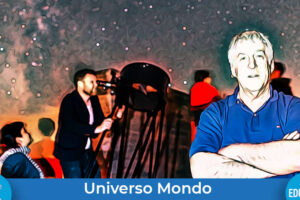Aggiornato il 28 Novembre 2024

As usual in this column, tell us about your work and the path that led you there…
I’m an astrophysicist and science communicator at timeanddate. I first got involved with the timeanddate team when Steffen Thorsen, our CEO, magnificently agreed to sponsor a project I was running in Angola for a solar eclipse in February 2017. We then started working together on live broadcasts of eclipses, and eventually I became a full-time member of the team.
Before that, I was teaching at a university in Japan, and running solar eclipse outreach projects in my spare time. I originally studied astrophysics at Royal Holloway, University of London, and later did a masters in science communication and public engagement at the University of Edinburgh.

When and why did you start focussing on science communication?
I was really inspired by something Stephen Jay Gould wrote. He told the story of his graduate evolutionary biology students, who tended to read On the Origin of Species and say, “Great, I enjoyed the popular version for the public. Now where’s the technical version for the specialists?” Gould told them there isn’t one: Darwin chose to present his revolutionary ideas in a format accessible to all. When I read the Origin I was blown away by how Darwin communicates “” how carefully and thoughtfully he helps the reader along.
What is timeanddate and what does an astrophysicist do there?
We’re a team of around 30 people, including programmers, designers, and journalists. We provide time, calendar, and astronomy information. On the astronomy side, we have a range of interactive tools that can be set to your location, such as our eclipse pages and Night Sky Map. We also have explanatory articles, news stories, and videos.
Our website is primarily aimed at “˜the person in the street’, but we’re always there for the astronomy community. We work closely with professional and amateur astronomers around the world, and we often collaborate with Astronomers Without Borders. We’re also excited to be involved in a project with INAF, where we’re organising a session on astronomy outreach at the Europlanet Science Congress 2022.
Does your work take you around the world to chase eclipses and other fascinating astronomical phenomena?
timeanddate’s live stream teams have captured everything from an eclipsed sunset behind the Andes Mountains, to an eclipsed moonset behind the Atlas Mountains. We even caught the first meteorite to be seen hitting the Moon during a lunar eclipse! During the covid crisis we were unable to travel ourselves, but this opened up wonderful opportunities for us to partner with observatories and astronomy clubs. It’s terrific fun “” and a huge privilege “” to work with talented astronomers in different countries, and to be able to share their live feeds with the world.

How many eclipses have you seen yet? Which one is your favorite?
My eclipse count is pitifully small compared to some. The solar physicist Jay Pasachoff told me that this year’s solar eclipses would be his 75th and 76th. Compared to that, my number isn’t worth mentioning… It’s impossible to choose a favourite, but the first one is always special. I’m part of the August 1999 generation who saw their first total eclipse somewhere in Europe.
Me too! Even though I only managed to be at 99% visibility on that day, so sadly it doesn’t really count. Where did you see that glorious eclipse?
After a nail-biting morning driving around northern France looking for clear skies, we had a perfect view from a field somewhere near the city of Amiens.
Why do you think eclipses are so captivating, and how can we best use them to raise awareness towards astronomy?
In a paper for the International Astronomical Union last year I described eclipses as “an end of the world simulation”. That’s certainly how they always feel to me.
In terms of using them to raise awareness, they’re a powerful reminder that the sky is full of intricate movement. These movements are subtle and easy to miss if we’re not paying attention: the slowly shifting positions of sunrise and sunset over the course of a year, or the monthly wanderings of the Moon through the daytime and nighttime skies. The beautiful thing about eclipses is that they start off subtle, but turn into something that is anything but subtle “” we can hardly fail to miss the Sun disappearing in the middle of the day.

When can we expect the next few solar and lunar eclipses?
In November 2022 there’ll be a big lunar eclipse visible from North and South America, Australia, and Asia. We then begin a spectacular run of total and annular solar eclipses: Australia in April 2023, North and South America in October 2023, and North America in April 2024.
Looking ahead a bit further, in August 2026 and August 2027 we’ll have the first total solar eclipse in mainland Europe since 1999. And in July 2028 a solar eclipse will produce four minutes of totality in Sydney, Australia. We have a complete list of forthcoming eclipses here.
Any tips to observe them?
Solar eclipses happen quickly, and the path of totality or annularity is fairly narrow. The first essential thing is to plan ahead, and make sure you’re in a good location at the right time. There are lots of resources that can help with planning “” for example, our eclipse maps give the average cloud cover for a particular location around the date of an eclipse. The second essential thing is to be serious about eye safety.
Lunar eclipses are more relaxed: they happen more slowly, and can be seen from anywhere on the nighttime side of the Earth. When I interviewed him for a timeanddate news story, astronomer Ed Krupp had an excellent piece of lunar eclipse advice: watch the whole thing. The surprises and delights are in the nuances and details.
What are some good practices that you learnt from covering eclipses around the world?
One thing we’ve learned is the value of investing time in preparation and practice. Work on back-up plans, test and re-test equipment, and rehearse what you’re going to do on the day.
Even if your only piece of equipment is going to be a pair of eclipse glasses, practice using them. (That last bit of very good advice came out of a discussion we had with Ralph Chou, the world’s leading authority on eye injuries caused by solar eclipse viewing.)

Would you like to tell us more about any other of your ongoing projects?
An interesting piece of science communication that has sparked a bit of media interest for us recently has been the story of Earth’s rotation. On average, the Earth rotates with respect to the Sun once every 86,400 seconds, which is 24 hours. In practice, this varies by milliseconds. Since accurate measurements with atomic clocks started in the 1960s, the Earth has generally been spinning a bit slow. But in 2020 it put on a burst of speed. The story we uncovered in the data was that, during a two-and-a-half-month period that summer, we had the 28 shortest days ever recorded in the era of atomic clocks.
The idea of there being surprise and unpredictability in something as seemingly steady and reliable as the Earth’s rotation really seemed to capture people’s imagination. The story is still continuing, and the first ever negative leap second is starting to become a possibility. The exciting thing is that we just don’t know yet where this story is heading.
You lived and worked in many countries, from the UK to Japan and Spain… How would you describe the status of astronomy outreach and public awareness there?
I’m currently based in Spain, and timeanddate is based in Stavanger, so I’m also a regular visitor to Norway. In all the countries mentioned there are outstanding examples of astronomy outreach. For example, our friends at Subaru Telescope in Hawaii, which is run by the National Astronomical Observatory of Japan, do an amazing job of raising awareness in Japan and beyond, and they’re superb partners for our eclipse live streams.
In Spain right now there’s a fascinating example of the exponential build-up of awareness we tend to see for eclipses. By exponential I mean that the growth is difficult to detect at first, but goes off the chart towards the end. In just a few years’ time, in 2026 and 2027, Spain will host the first total solar eclipses in mainland Europe for almost three decades. We know Spain will do a brilliant job of making the most of these events. But right now the level of awareness in the country is more or less zero. This isn’t a Spanish thing “” it’s a pattern we see at most eclipses.

How do you think our discipline can help make a difference in science outreach today and engage audiences from all backgrounds with science?
Our discipline is accessible to all, and it’s universal. This universality gives us a connection with every audience. As is often said, we all share the same sky. At the same time, it’s also true that we *don’t* share the same sky. The sky looks very different at different latitudes, and things move in different ways. The magic of things like solar eclipses or lunar occultations only happen across very small areas. This uniqueness gives us another way to connect with audiences.
The marvelous thing about astronomy is that we can give people detailed information for their own backyard or balcony, wherever that happens to be in the world. When and where will Jupiter rise? Which star is that? What’s the best time to catch a meteor shower? The more we can give people personalized information, the better we can engage them. That’s what we’re really interested in doing at timeanddate.




Add Comment